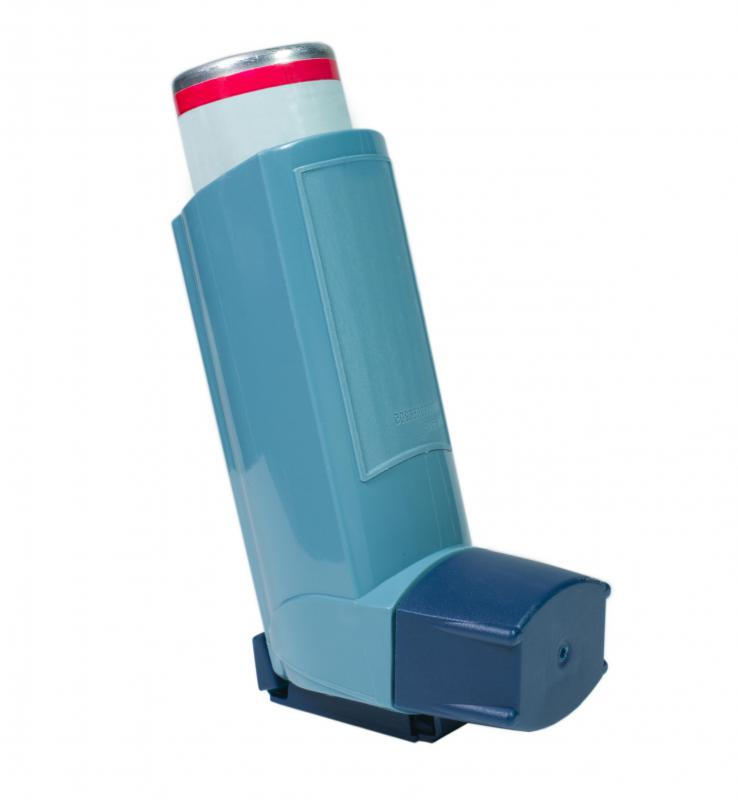At TheHealthBoard, we're committed to delivering accurate, trustworthy information. Our expert-authored content is rigorously fact-checked and sourced from credible authorities. Discover how we uphold the highest standards in providing you with reliable knowledge.
What is an Inhaler?
An inhaler is a medical device that administers asthma medication to the lungs in an aerosolized form. These devices are used to deliver both maintenance and rescue medication, mostly for asthma, but also for those suffering from chronic obstructive pulmonary disease (COPD) or other respiratory conditions. The American Medical Association has approved use of the metered dose inhaler (MDI) for ages five and over, but many children under the age of five are prescribed an MDI by their pediatrician if they are coordinated enough to use it.
The MDI is the most commonly used type of inhaler. It consists of a small canister that holds the medicine. The medicine is administered in a specific dose, which saves the user from having to measure exactly how much he or she should inhale.

A plastic holder, which provides a place to hold the inhaler, has a mouthpiece at the bottom. The patient pushes down the top of the canister into the holder, which causes the propellant in the canister to mix with the medication to aerosolize it. A small puff comes out of the mouthpiece, which is then inhaled into the lungs. Experts recommend that the patient hold his or her breath for approximately ten seconds to allow absorption of the medication.

For small children, MDIs must be used with a spacer or chamber, which can be used with a mouthpiece or face mask. This chamber holds the medication and mixes it with air until it is drawn out by the child through a deep breath. This requires coordination and the ability to follow instructions on the child’s part. The chamber increases the effectiveness of the delivery of the medication if used properly.

Medications most often used in this type of dispenser include albuterol, which is one of many bronchodilators, and prednisone, which is a corticosteroid. These fast acting medications, when delivered straight to the lungs, should start to work within five to 15 minutes.
Another type is a dry powder inhaler, which dispenses the medicine in a powdered form. The medication is held within a chamber called a spacer, which is attached to the inhaler. The user then inhales the medication through a mouthpiece or mask. Although the spacer makes this type easier for children to use, it also requires some practice and coordination.

Many people prefer using MDIs to other means, such as nebulizers or dry powdered inhalers, because they are small enough to fit in a pocket or purse and cheap enough to stock up on. They also deliver medication quickly and easily. Another benefit is that, because the medication is administered directly into the lungs, rather than taken orally in liquid form and absorbed into the blood stream, there are fewer side affects and the medication works much faster.
AS FEATURED ON:
AS FEATURED ON:
















Discussion Comments
I use an albuterol inhaler for my asthma. It works very fast which is a great thing because my asthma attacks usually come on very fast too. Sometimes, I'm fine one minute, and wheezing the next.
Initially, my doctor had given me a different inhaler but it wasn't working fast enough. Or maybe my asthma became more severe or more acute, I'm not sure. But arbuterol works fine, so I plan on sticking with it if nothing changes. Like the article said, I think most asthma patients use arbuterol. My friend does too.
@serenesurface-- I'm not a doctor but as far as I know, inhalers containing bronchodilator medications can also be required for conditions like bronchitis or pneumonia triggered asthma.
Asthma is when the airways become narrow due to the contraction of muscles. It causes difficulty breathing. In the case of asthma, it occurs due to a trigger, usually allergies. But some other illnesses can cause a similar narrowing of the airways.
For example, someone who has an upper respiratory infection who doesn't get treatment in time may develop bronchitis or pneumonia which may cause asthma. Such patients are also given bronchodilator inhalers for their breathing problems.
I don't know if other groups are also administered through inhalers, but that's possible.
Do only asthma patients use inhalers or are they also used for other conditions?
I saw my cousin using an inhaler but as far as I know, she doesn't have asthma. I was going to ask her but she left in a hurry.
Post your comments